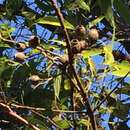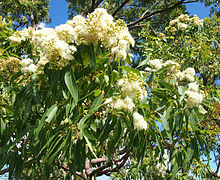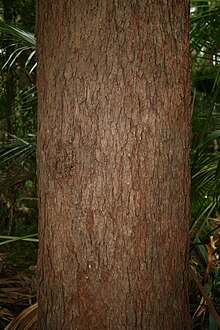fi
nimet breadcrumb-navigoinnissa


Corymbia intermedia ist eine Pflanzenart innerhalb der Familie der Myrtengewächse (Myrtaceae). Sie kommt an der Ostküste Australiens und in der westlich angrenzenden Great Dividing Range vor.[1] Sie wird dort „Pink Bloodwood“ genannt.[2]
Corymbia intermedia wächst als Baum, der Wuchshöhen bis 30 Meter erreicht. Die Borke verbleibt am gesamten Baum, ist rotbraun oder grau-braun und schachbrettartig.[3] Die kleinen Zweige besitzen eine grüne Rinde. Im Mark sind Öldrüsen vorhanden, in der Borke aber nicht.[4]
Bei Corymbia intermedia liegt Heterophyllie vor. Die Laubblätter sind immer in Blattstiel und Blattspreite gegliedert. Die Blattspreite an jungen Exemplaren ist elliptisch bis eiförmig[3] oder auch lanzettlich und besitzt steife Drüsenhaare und manchmal einfache Haare. Die Blattspreite an mittelalten Pflanzen ist elliptisch bis eiförmig, ganzrandig und glänzend grün.[4] Der Blattstiel an erwachsenen Exemplaren ist 8 bis 20 mm lang. Die auf Blattober- und -unterseite unterschiedlich glänzend grüne Blattspreite an erwachsenen Exemplaren ist relativ dick,[4] bei einer Länge von 10 bis 15 cm und einer Breite von 2 bis 3 cm lanzettlich[3] bis breit-lanzettlich oder eiförmig, gerade, mit sich verjüngender oder runder Spreitenbasis und spitzem oder zugespitztem oberen Ende. Die erhabenen Seitennerven gehen in geringen Abständen in einem stumpfen Winkel vom Mittelnerv ab. Auf jeder Blatthälfte gibt es einen ausgeprägten, durchgängigen, sogenannten Intramarginalnerv; er verläuft in geringem Abstand am Blattrand entlang. Die Keimblätter (Kotyledonen) sind fast kreisförmig.[4]
Endständig[4] auf einem bei einer Länge von 10 bis 18 mm im Querschnitt stielrunden Blütenstandsschaft steht ein zusammengesetzter Blütenstand, der aus doldigen Teilblütenständen mit jeweils etwa sieben Blüten besteht. Der Blütenstiel ist bei einer Länge von 2 bis 14 mm im Querschnitt stielrund.[3]
Die nicht blaugrün bemehlte oder bereifte Blütenknospe[4] ist bei einer Länge von 6 bis 8 mm und einem Durchmesser von 3 bis 4 mm ei- bis birnenförmig.[3] Die Kelchblätter bilden eine Calyptra, die bis zur Blüte (Anthese) vorhanden bleibt. Die glatte Calyptra ist halbkugelig oder konisch, schmaler als der glatte Blütenbecher (Hypanthium)[4] und kürzer als dieser.[3] Die Blüten sind weiß oder cremefarben.[4]
Die gestielte Frucht ist bei einer Länge von 10 bis 21 mm und einem Durchmesser von 8 bis 16 mm ei- bis urnenförmig und drei- bis vierfächerig.[4] Der Diskus ist eingedrückt, die Fruchtfächer sind eingeschlossen.[3]
Der regelmäßige und seitlich abgeflachte, kahn- oder eiförmige Samen besitzt eine netzartige, matte bis seidenmatte, rotbraune Samenschale. Das Hilum befindet sich am oberen Ende des Samens.[4]
Das natürliche Verbreitungsgebiet von Corymbia intermedia erstreckt sich an der Ostküste Australiens entlang von Gloucester im nordöstlichen New South Wales bis Cooktown in Queensland. Auch auf der angrenzenden Ostabdachung der Great Dividing Range findet man Corymbia intermedia.[1][3][4]
Corymbia intermedia wächst bevorzugt und örtlich vorherrschend in Küstenwäldern, auf mäßig fruchtbaren Böden.[3][4]
Die Erstbeschreibung erfolgte 1901 durch Richard Thomas Baker unter dem Namen (Basionym) Eucalyptus intermedia R.T.Baker in Proceedings of the Linnean Society of New South Wales, Volume 25, S. 674, Tafel XLVI, Fig. 1. Das Typusmaterial weist die Beschriftung Ballina (W. Bäuerlen), Richmond and Clarence Rivers (Rev. Dr. Woolls), Barney’s Wharf, Cambewarra, (W. Bäuerlen, P. Macpherson) auf.[2] Das Artepitheton intermedia ist vom lateinischen Wort intermedius für zwischengelagert abgeleitet und bezieht sich auf die Eigenschaften des Eukalyptusöls, die zwischen denen des „Red Bloodwood“ (Corymbia gummifera) und denen des „Yellow Bloodwood“ (Corymbia eximia) liegen.[5] Die Neukombination zu Corymbia intermedia (R.T.Baker) K.D.Hill & L.A.S.Johnson erfolgte 1995 durch Kenneth D. Hill und Lawrence Alexander Sidney Johnson unter dem Titel Systematic studies in the eucalypts, 7. A revision of the bloodwoods, genus Corymbia (Myrtaceae) in Telopea, Volume 6 (2-3), S. 247.[2][6] Ein weiteres Synonym für Corymbia intermedia (R.T.Baker) K.D.Hill & L.A.S.Johnson ist Eucalyptus gummifera var. intermedia (R.T.Baker) Domin.[2][7]
Die Farbe des Kernholzes variiert von altrosa über tiefrot bis rotbraun und sein spezifisches Gewicht liegt bei etwa 1010 kg/m³. Wie das von Corymbia gummifera und Corymbia polycarpa dient das Holz beispielsweise zur Herstellung von Balken, Eisenbahnschwellen Hartfaserplatten und Zäunen[8] Sägespäne können die Augen reizen.[5]
Der englische Trivialname leitet sich aus der Holzfarbe ab, die auf die Harznerven zurückzuführen ist.[9]
Corymbia intermedia ist eine Pflanzenart innerhalb der Familie der Myrtengewächse (Myrtaceae). Sie kommt an der Ostküste Australiens und in der westlich angrenzenden Great Dividing Range vor. Sie wird dort „Pink Bloodwood“ genannt.
Corymbia intermedia, commonly known as pink bloodwood,[2] is a species of medium to tall tree that is endemic to north-eastern Australia. It has rough, tessellated bark on the trunk and branches, flower buds in groups of seven, white flowers and oval to barrel-shaped fruit.
The pink bloodwood is tree that can reach 20–30 m (65–100 ft) in height with a 10–20 m (35–65 ft) spread. The bark is rough, tessellated, light brown to grey in colour and extends from the trunk to the branches. Young plants and coppice regrowth have lance-shaped, dark green leaves that are paler on the lower surface, 80–160 mm (3.1–6.3 in) long and 20–42 mm (0.79–1.65 in) wide and petiolate. Adult leaves are arranged alternately, leathery, paler on the lower surface, lance-shaped, 80–150 mm (3.1–5.9 in) long and 13–40 mm (0.51–1.57 in) wide on a petiole 12–25 mm (0.47–0.98 in) long. The flower buds are arranged on the ends of branchlets on a branched peduncle 10–20 mm (0.39–0.79 in) long, each branch of the peduncle with seven buds on pedicels 2–15 mm (0.079–0.591 in) long. Mature buds are pear-shaped to oval, 7–10 mm (0.28–0.39 in) long and 4–6 mm (0.16–0.24 in) wide with a conical to rounded or beaked operculum. Flowering occurs from December to March and the profuse perfumed white or cream flowers are up to 20 mm (0.79 in) in diameter. The fruit is an urn-shaped, oval or barrel-shaped capsule 10–20 mm (0.39–0.79 in) long and 8–16 mm (0.31–0.63 in) wide with a short neck and the valves enclosed in the fruit.[2][3][4][5][6][7]
The pink bloodwood resembles the red bloodwood, and the two species co-occur in central New South Wales. The latter species can be distinguished by its larger gumnuts and winged seeds.[4]
Richard Thomas Baker was the first to formally describe the pink bloodwood in 1901, naming it Eucalyptus intermedia, and publishing the description in Proceedings of the Linnean Society of New South Wales.[8][9] The species name is derived from the Latin adjective intermedius and is based on the intermediate nature of the oils between the red and yellow bloodwoods.[4] In 1995, the genus Eucalyptus was split into three genera by Ken Hill and Lawrie Johnson, with E. intermedia transferred into Corymbia.[7][10]
Hill and Johnson classified Corymbia intermedia in its own series Intermediae,[7] A combined analysis of nuclear rDNA (ETS + ITS) and morphological characters published in 2009 found it to be closely related to C. trachyphloia and C. hendersonii. C. intermedia and other species were placed in the large section Septentrionales within the subgenus Corymbia.[11] The common name comes from the gum veins in the wood.[12]
The species is found in New South Wales from Gloucester northwards into Queensland,[5] as far as to Cape York — a total range of 2,500 km (1,600 mi) — and within 100 km (62 mi) of the eastern coastline. It thrives on loamy and sandy soils,[4] and has been found on altitudes of up to 1,200 metres (3,900 feet), with annual rainfall of 750–2200 mm and predominantly summer rain.[4] It grows in open forest, or occasionally lone trees grow in closed forest or on the margins of rainforests. It is associated with such species as carbeen (Corymbia tesselaris), broad-leaved stringybark (Eucalyptus caliginosa), forest red gum (E. tereticornis), narrow-leaved ironbark (E. crebra), scribbly gum (E. racemosa), grey gum (E. propinqua), blackbutt (E. pilularis), flooded gum (E. grandis), red mahogany (E. resinifera), and black sheoak (Allocasuarina littoralis) and red wattle (Acacia flavescens) in coastal north Queensland.[4]
In Bungawalbin National Park in northern New South Wales, the squirrel glider( Petaurus norfolcensis) has been observed biting and gouging into the bark to make a wound on the trunk of the pink bloodwood and then lick the sap out.[13] The behaviour has also been recorded for the yellow-bellied glider (P. australis) for this species.[14] Study of the forest habitat of the sugar glider (P. breviceps) and mahogany glider ( P. gracilis) found that the presence of pink bloodwood was correlated with the presence of the former and absence of the latter species.[15]
Study of the impact of perioding burning in forest in southeastern Queensland found no significant difference in trunk diameter of pink bloodwoods in unburnt forest compared with forests burnt every two or four years.[16]
The dark pink to reddish-brown heartwood is hard and durable usable for building fences and bridges. The sawdust of pink bloodwood is an irritant to eyes and skin.[4]
Corymbia intermedia may be used as a rootstock, onto which the ornamental Corymbia ficifolia is grafted.[17]
 Flowers and foliage.
Flowers and foliage.  closeup of bark on trunk
closeup of bark on trunk Corymbia intermedia, commonly known as pink bloodwood, is a species of medium to tall tree that is endemic to north-eastern Australia. It has rough, tessellated bark on the trunk and branches, flower buds in groups of seven, white flowers and oval to barrel-shaped fruit.
Corymbia intermedia, appelé communément gommier rosâtre[1], est une espèce du genre Corymbia, famille des Myrtaceae.
Corymbia intermedia est un arbre qui peut atteindre une hauteur de 35 m[1]. L'écorce reste sur l'arbre entier, est brun rougeâtre ou gris-brun[2] et en forme de damier. Les petites branches ont une écorce verte. Il y a des glandes à huile dans la moelle, mais pas dans l'écorce[3].
Corymbia intermedia est hétérophylle. Les feuilles sont toujours divisées en pétiole et en limbe. Le limbe des jeunes individus est elliptique à ovale[2] ou lancéolé et présente des poils glandulaires raides et parfois des poils simples. La feuille du limbe des plantes d'âge moyen est elliptique à ovale, verte entière et brillante[3]. Le pétiole des spécimens adultes mesure de 8 à 20 mm de long. Le dessus et le dessous des feuilles vert brillant sur les spécimens adultes sont relativement épaisses[3], d'une longueur de 10 à 15 cm et d'une largeur de 2 à 3 cm[2], lancéolée à largement lancéolée ou ovée, droite, conique ou ronde avec une base rajeunissante ou ronde et une extrémité supérieure pointue. Les nerfs surélevés vont à de petites distances à un angle obtus du nerf médian. Sur chaque moitié de la feuille il y a un nerf intramarginal prononcé, continu. Les cotylédons sont presque circulaires[3].
L'inflorescence se fait une tige de 10 à 18 mm, chacune avec environ sept fleurs. Le pédicelle est en forme de tige avec une longueur de 2 à 14 mm[2].
Le bouton de fleur fariné non-bleu-vert ou dépoli[3] est en forme de poire avec une longueur de 6 à 8 mm et un diamètre de 3 à 4 mm[2]. Les sépales forment un calyptre qui reste jusqu'à la fleur (anthèse). Le calyptre lisse est hémisphérique ou conique, plus étroit que le calice lisse (hypanthium)[3] et plus court que celui-ci[2]. Les fleurs sont blanches ou crème[3].
Le fruit pédonculé a une longueur de 10 à 21 mm et un diamètre de 8 à 16 mm, en forme d'œuf ou d'urne, avec trois à quatre valves[1],[3].
La graine régulière et aplatie latéralement, barrée ou en forme d'œuf, a un spermoderme réticulaire, terne à semi-mat, rouge-brun. Le hile est au sommet de la graine[3].
Corymbia intermedia se trouve en Nouvelle-Galles du Sud, de Gloucester au nord jusqu'au Queensland, à la péninsule d'York[1], soit une distance totale de 2 500 km et à moins de 100 km de la côte est. Il pousse sur les sols limoneux et sablonneux[4] et à des altitudes allant jusqu'à 1 200 m, avec des précipitations annuelles modérées[1] de 750 à 2 200 mm et des pluies principalement estivales[4]. Il est présent dans la forêt ouverte, ou parfois des arbres seuls poussent dans une forêt fermée ou sur les marges des forêts tropicales.
Corymbia intermedia est associé à des espèces comme Corymbia tessellaris, Eucalyptus caliginosa, Eucalyptus tereticornis, Eucalyptus crebra, Eucalyptus racemosa, Eucalyptus propinqua, Eucalyptus pilularis, Eucalyptus grandis, Eucalyptus resinifera, Allocasuarina littoralis et Acacia flavescens[4].
Dans le parc national de Bungawalbin, au nord de la Nouvelle-Galles du Sud, on a observé le phalanger de Norfolk mordre et creuser dans l'écorce pour faire une plaie dans le tronc puis lécher la sève. Le comportement fut aussi enregistré pour Petaurus australis. L'étude de l'habitat forestier du phalanger volant et du Petaurus gracilis montre que la présence du gommier rosâtre était corrélée avec la présence de la première espèce et l'absence de la dernière espèce.
Le bois de cœur rose foncé à brun rougeâtre. Son poids spécifique est d'environ 1 010 kg/m3. Comme Corymbia gummifera et Corymbia polycarpa, il est dur et durable pour des poutres, des traverses de chemin de fer, des panneaux durs et des clôtures. La sciure de gommier rosâtre est irritante pour les yeux et la peau[4].
Corymbia intermedia, appelé communément gommier rosâtre, est une espèce du genre Corymbia, famille des Myrtaceae.
Corymbia intermedia là một loài thực vật có hoa trong Họ Đào kim nương. Loài này được (F.Muell. ex R.T.Baker) K.D.Hill & L.A.S.Johnson mô tả khoa học đầu tiên năm 1995.[1]
Corymbia intermedia là một loài thực vật có hoa trong Họ Đào kim nương. Loài này được (F.Muell. ex R.T.Baker) K.D.Hill & L.A.S.Johnson mô tả khoa học đầu tiên năm 1995.